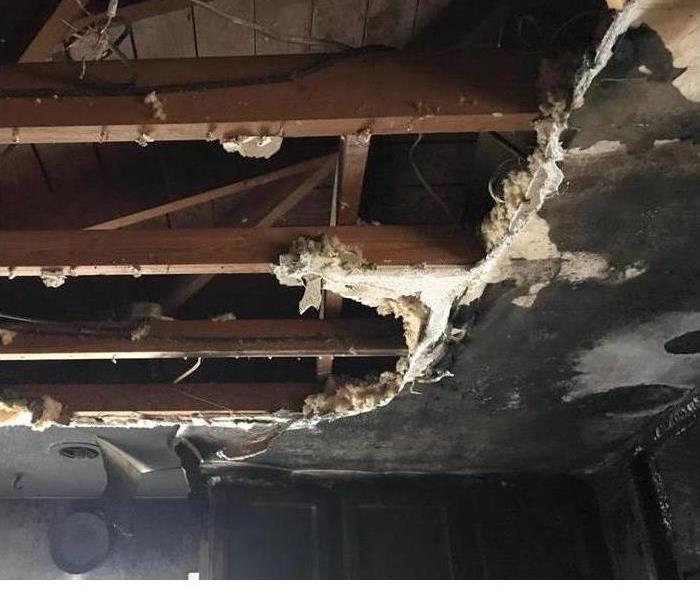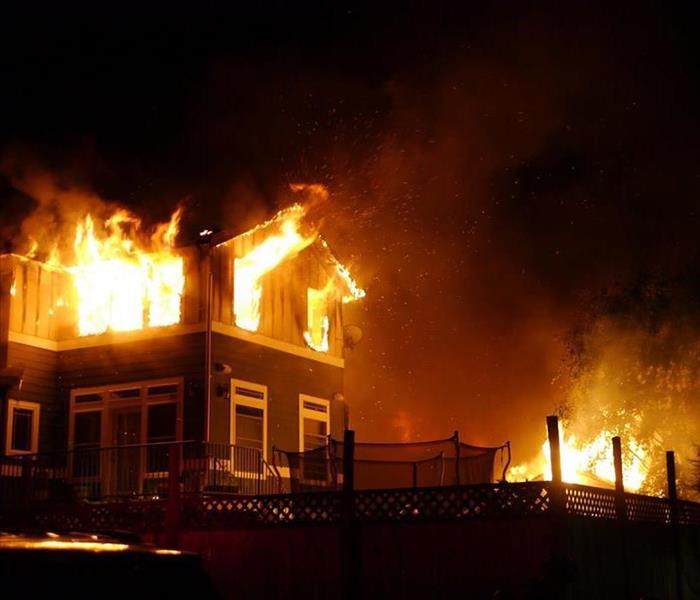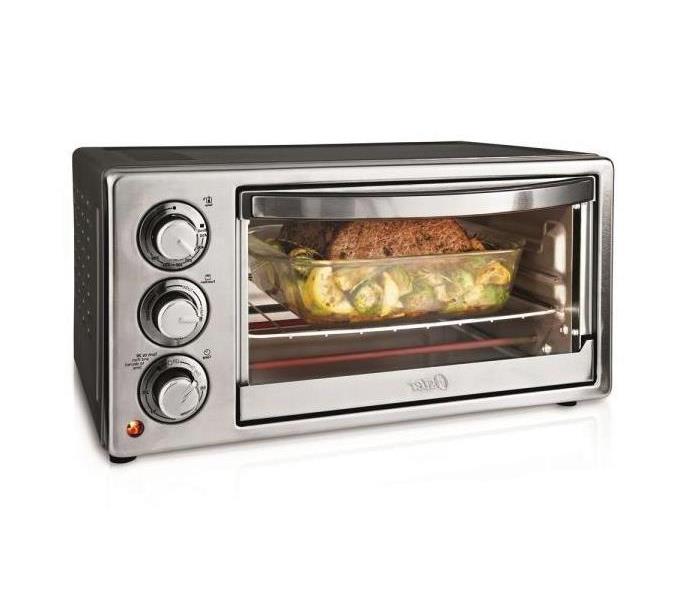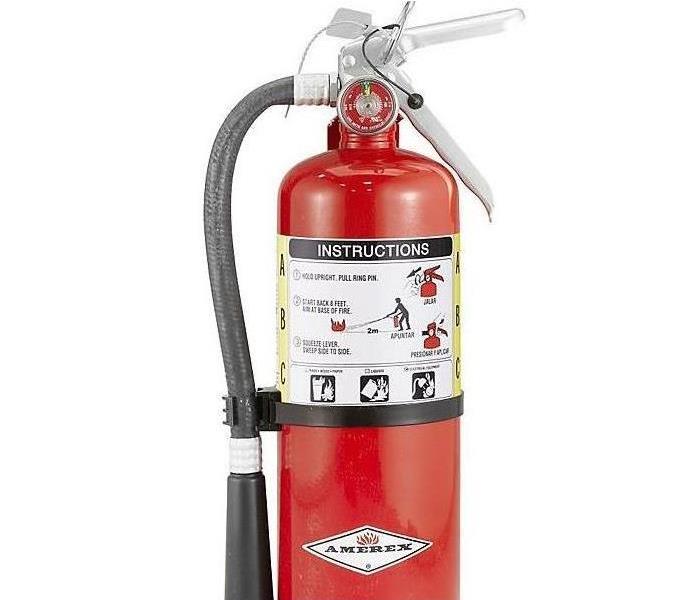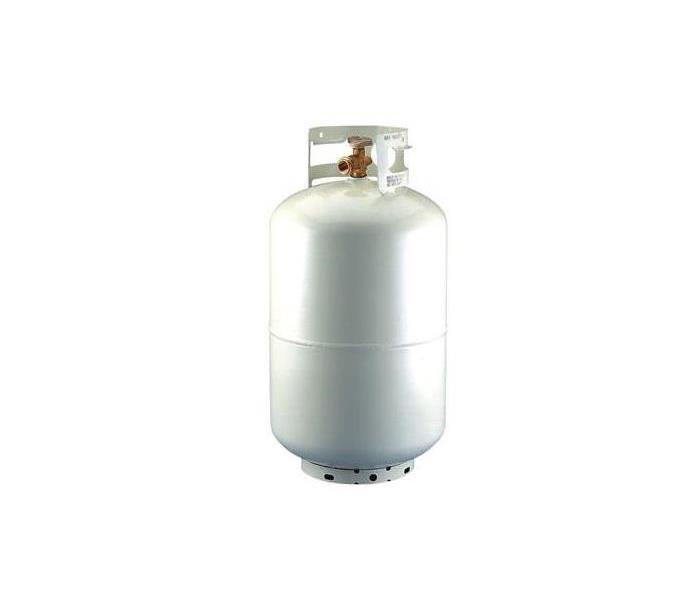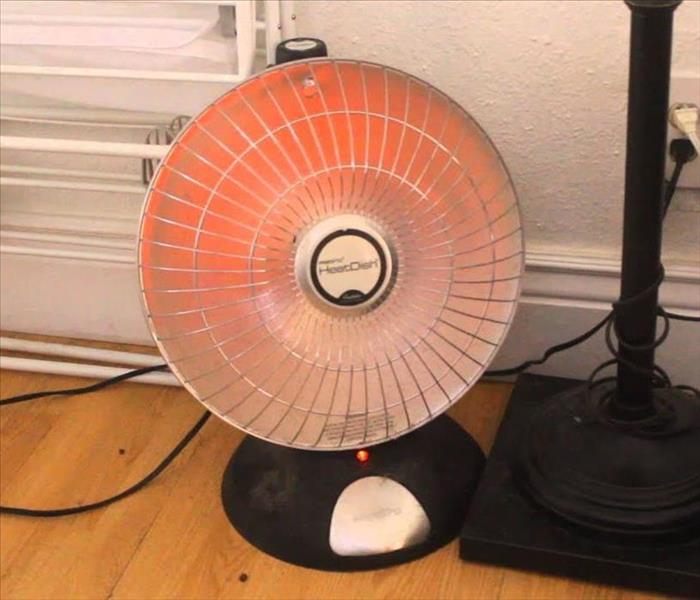Archived Fire Damage Blog Posts
SERVPRO®: Your Partner in Fire Damage Restoration
12/14/2024 (Permalink)
Experiencing a fire can be devastating, leaving behind physical damage, emotional stress, and uncertainty about what comes next. SERVPRO is here to guide you through the fire damage restoration process, helping you rebuild and restore your home or business with care and expertise.
Understanding Fire Damage
Fire damage isn’t limited to the areas touched by flames. Smoke, soot, and water from firefighting efforts can permeate walls, furniture, and belongings, leading to further damage if not addressed quickly. Immediate and professional restoration is crucial to prevent long-term issues like structural instability, odors, and staining.
SERVPRO’s Comprehensive Fire Damage Restoration Process
1. Emergency Response and Inspection
SERVPRO’s team is available 24/7 to respond to your call. Upon arrival, we assess the extent of the damage, identifying areas affected by fire, smoke, soot, and water. This detailed evaluation allows us to create a tailored restoration plan.
2. Board-Up and Tarping Services
To protect your property from weather elements or unauthorized access, SERVPRO provides emergency board-up and tarping services. This step ensures your home or business remains secure during the restoration process.
3. Water Removal and Drying
If water was used to extinguish the fire, SERVPRO removes standing water and uses industrial-grade dehumidifiers and air movers to dry affected areas thoroughly, preventing mold and secondary damage.
4. Smoke and Soot Removal
Smoke and soot can cling to surfaces and penetrate deeply into materials. Using advanced cleaning methods and equipment, SERVPRO removes residues from walls, ceilings, and belongings, restoring them to pre-fire condition wherever possible.
5. Odor Neutralization
SERVPRO employs specialized equipment like ozone generators and thermal foggers to eliminate lingering smoke odors, ensuring your space smells fresh and clean.
6. Cleaning and Sanitization
From furniture to electronics, SERVPRO carefully cleans and sanitizes your belongings using specialized techniques. Items that are irreparable are documented for insurance purposes.
7. Restoration and Repairs
Once the cleaning and mitigation steps are complete, SERVPRO handles the final restoration, which may include drywall replacement, painting, and rebuilding damaged structures. Our goal is to return your property to its pre-fire condition quickly and efficiently.
Why Choose SERVPRO?
• Rapid Response: Time is critical after a fire. SERVPRO responds promptly to minimize damage and accelerate recovery.
• Certified Expertise: Our technicians are trained and certified in fire and smoke restoration techniques.
• Advanced Equipment: SERVPRO uses industry-leading tools and cleaning methods to ensure comprehensive restoration.
• Insurance Assistance: We work directly with your insurance company, helping you navigate the claims process with ease.
• Comprehensive Services: From initial cleanup to full reconstruction, SERVPRO manages every aspect of your restoration.
Don’t let fire damage disrupt your life longer than necessary. With SERVPRO’s expertise and commitment to quality, you can trust that your property is in good hands.
Call SERVPRO Today
If you’ve experienced a fire, contact SERVPRO for a professional assessment and tailored restoration plan. We’re here to help you every step of the way.
FAQs
Q: How long does fire damage restoration take?
A: The timeline depends on the extent of the damage. SERVPRO provides a detailed estimate and timeline after the initial inspection.
Q: Can SERVPRO save belongings damaged by smoke?
A: Yes, SERVPRO uses specialized techniques and equipment to clean and restore many smoke-damaged items.
Q: Will SERVPRO help with my insurance claim?
A: Absolutely. SERVPRO provides detailed documentation of the damage and works directly with your insurance company to simplify the claims process.
Restoring Hope After Fire Damage with SERVPRO®
11/24/2024 (Permalink)
A fire can be one of the most devastating events for a home or business, leaving behind not only structural damage but also emotional scars. Once the flames are out, the real challenge begins: rebuilding and restoring your property to its former condition. SERVPRO specializes in comprehensive fire damage restoration, providing expert care and support every step of the way.
The Aftermath of Fire Damage
Fire damage extends beyond the visible destruction of flames. Its impact can include:
- Smoke and Soot Residue: Lingering particles can damage surfaces and degrade air quality.
- Water Damage: Efforts to extinguish the fire often leave behind water damage.
- Structural Compromise: Heat can weaken walls, ceilings, and other critical elements.
- Lingering Odors: The smell of smoke can permeate everything from furniture to clothing.
How SERVPRO Addresses Fire Damage
SERVPRO combines advanced technology and experienced technicians to provide a full-scale restoration process, ensuring your property is safe, clean, and welcoming again.
Step 1: Emergency Response
Available 24/7, SERVPRO responds quickly to assess the extent of fire, smoke, and water damage.
Step 2: Safety and Containment
Our team prioritizes safety, securing compromised areas and preventing further damage. This includes boarding up windows and covering damaged roofs if necessary.
Step 3: Smoke and Soot Removal
Using specialized techniques and equipment, SERVPRO removes smoke and soot from walls, ceilings, and other surfaces. This step ensures your property is not only clean but also free from harmful residues.
Step 4: Water Extraction and Drying
If water damage from firefighting efforts is present, SERVPRO employs industrial-grade equipment to remove water and thoroughly dry affected areas.
Step 5: Cleaning and Sanitizing
SERVPRO deep-cleans every surface, restoring items where possible and discarding those that are irreparably damaged. We also eliminate odors with advanced deodorization techniques.
Step 6: Full Restoration
From repairing drywall to replacing damaged flooring, SERVPRO restores your property to pre-fire condition, making it “Like it never even happened.”
Why SERVPRO for Fire Damage Restoration?
- Certified Expertise: SERVPRO technicians are trained and certified in fire restoration, bringing proven skills to every project.
- Comprehensive Care: Our services address every aspect of fire damage, from initial cleanup to final repairs.
- Compassionate Support: We understand the emotional toll of fire damage and are committed to easing your stress throughout the process.
- Advanced Technology: From HEPA filtration to odor neutralizers, SERVPRO uses cutting-edge tools for effective restoration.
Tips for Dealing with Fire Damage
- Avoid Cleaning on Your Own: Improper cleaning can worsen smoke damage. Leave it to the professionals.
- Contact Your Insurance Provider: Notify your insurer immediately and document the damage for your claim.
- Stay Safe: Avoid entering the property until it has been inspected and deemed safe by professionals.
Ready to Help When You Need It Most
At SERVPRO, we understand the urgency and complexity of fire damage restoration. Our team works quickly to restore your property while keeping you informed every step of the way.
Call SERVPRO for Professional Fire Damage Restoration
When fire disrupts your life, SERVPRO is here to restore your home or business with care and expertise. Contact us today to schedule an assessment and start the recovery process.
Q&A
Q: Can SERVPRO remove smoke odors from furniture and clothing?
A: Yes, SERVPRO uses advanced deodorization techniques to eliminate smoke odors from affected items whenever possible.
Q: How long does fire damage restoration take?
A: The timeline depends on the extent of the damage. SERVPRO provides an estimated schedule after an initial assessment.
Q: Will SERVPRO help with insurance claims?
A: Absolutely. SERVPRO works closely with your insurance provider, offering detailed documentation and support throughout the claims process.
With SERVPRO by your side, fire damage doesn’t have to mean the end. Trust us to help you rebuild and restore with professionalism and care.
Advice on how to be safe from fire
10/9/2023 (Permalink)
Being prepared and knowledgeable about fire safety is crucial to ensure your safety and the safety of others in the event of a fire. Here are some essential tips to help you stay safe from fires:
1. **Install Smoke Alarms and Carbon Monoxide Detectors:**
- Place smoke alarms on every floor of your home, especially near bedrooms and in common areas.
- Test smoke alarms regularly and replace batteries at least twice a year.
2. **Create a Fire Escape Plan:**
- Develop a clear and practical fire escape plan for your home or workplace.
- Identify primary and secondary escape routes from each room.
- Practice the escape plan regularly with all family members or colleagues.
3. **Know How to Use Fire Extinguishers:**
- Keep fire extinguishers in key areas of your home, such as the kitchen, garage, and near potential fire hazards.
- Learn how to use a fire extinguisher and understand the PASS (Pull, Aim, Squeeze, Sweep) technique.
4. **Keep Fire Hazards in Check:**
- Regularly inspect and maintain electrical appliances, cords, and outlets for signs of wear or damage.
- Don't overload electrical outlets or extension cords.
- Avoid using damaged electrical appliances and cords.
5. **Practice Fire-Safe Cooking:**
- Never leave cooking unattended, especially on the stovetop.
- Keep flammable items, such as towels and curtains, away from cooking surfaces.
- Use caution when cooking with oil or deep frying; always have a lid nearby to cover the pan if needed.
6. **Maintain Heating Equipment:**
- Have heating systems, chimneys, and fireplaces inspected and cleaned annually by professionals.
- Use appropriate safety measures when using space heaters, ensuring they're placed away from flammable materials and turned off when not in use.
7. **Be Mindful of Candles and Open Flames:**
- Keep candles away from flammable materials and never leave them unattended.
- Consider using flameless LED candles as a safer alternative.
8. **Store Hazardous Materials Safely:**
- Store flammable liquids and chemicals in a well-ventilated area away from heat sources.
- Follow proper storage guidelines for household chemicals and fuels.
9. **Educate Your Family and Team:**
- Educate everyone in your household or workplace about fire safety procedures and prevention.
- Teach children about the dangers of fire and what to do in case of a fire.
10. **Know How to React During a Fire:**
- If a fire occurs, stay low to the ground to avoid smoke inhalation and crawl to safety if necessary.
- Call emergency services immediately once you are in a safe location.
11. **Keep Important Documents Secure:**
- Store important documents (e.g., passports, insurance policies, medical records) in a fireproof safe or a secure off-site location.
Remember, being proactive and prepared can make a significant difference in ensuring your safety and the safety of others in the event of a fire.
Average Time for Fire Damage Repair
9/9/2022 (Permalink)
If your home has been damaged by fire, you may be wondering how long it would take to repair it. While small damage can be repaired in a few days, serious damage can take weeks or months to fix. However, no fire damage restoration can commence until the fire service has cleared the area. Depending on the jurisdiction, this process can take many days or weeks. Here's all you need to know about repairing fire damage.
First and foremost, the property must be secured. This includes enclosing the area with fencing and cleaning up any debris left behind. To prevent cross-contamination, you should also seal off roofs and tarp them. After the initial cleanup, you should hire an expert to help you.
Fire damage restoration typically entails rebuilding the home's structural parts as well as repairing or replacing destroyed items. Painting and drywall installation are examples of additional services. Some fire damage restoration businesses provide complete reconstruction services, while others merely perform certain repairs. If you have a lot of drywall damage, you might want to hire a business that specialises in removing and storing smoke and soot stains. Jenkins Restoration can help you restore your house or apartment to its original condition, regardless of the type of fire damage restoration you require.
Understanding The Research On Electrical Fires May Help You Avoid One In Your Home
9/9/2022 (Permalink)
Electrical Fires
Fires involving electrical failures or malfunctions accounted for the highest share of civilian deaths (18%) and direct property damage (20%). This is according to a National Fire Protection Association report that was done in 2019.
Home electrical fires can start in wiring, electrical distribution systems, and lighting equipment, as well as in any equipment powered by electricity such as cooking, heating, office and entertainment equipment, washers and dryers, as well as electrical distribution or lighting equipment.
If you own an older home, it's important that you have your outlets and wiring checked. Aging electrical systems in older homes can be a source of arc faults, either through normal wear and tear or because the systems cannot accommodate the greater demands of modern appliances.
We can respond immediately to your emergency and have the expertise to handle your restoration or cleaning needs.
Fire Research Information Might Help To Keep Your Family Safe
More than one-quarter of the reported fires occurred in home environments, according to the National Fire Protection Association. They have also researched specific causes.
Most home fires and fire casualties result from five causes: cooking, heating equipment, electrical distribution and lighting equipment, intentional fire setting, and smoking materials.
Here are some tips to help avoid some of these causes:
Cooking
Stay in the kitchen when you are frying, grilling, or broiling food.
If you leave the kitchen for even a short period of time, turn off the stove.
Wear short, close-fitting or tightly rolled sleeves when cooking.
Keep children away from cooking areas by enforcing a "kid-free zone" of 3 feet around the stove.
Position barbecue grills at least 10 feet away from siding and deck railings, and out from under eaves and overhanging branches.
Smoking
Smoke outside and completely stub out butts in an ashtray or a can filled with sand.
Soak cigarette butts and ashes in water before throwing them away.
Never toss hot cigarette butts or ashes in the trash can.
Never smoke in a home where oxygen is used, even if it is turned off.
Oxygen can be explosive and makes fire burn hotter and faster.
Be alert - don’t smoke in bed! If you are sleepy, have been drinking, or have taken medicine that makes you drowsy, put your cigarette out first.
Electrical and Appliance Safety
Frayed wires can cause fires.
Replace all worn, old or damaged appliance cords immediately and do not run cords under rugs or furniture.
If an appliance has a three-prong plug, use it only in a three-slot outlet.
Never force it to fit into a two-slot outlet or extension cord.
We are ready to help when you have fire damage
5 Cooking Tips for Fire Safety
5/2/2022 (Permalink)
Five Cooking Tips You Can Use For Fire Safety
After a kitchen fire, there are a few steps you can follow to help prevent a fire in the first place. Here are five cooking tips you can use for fire safety.
1. Keep The Cooking Area Clean
One way to help avoid fire damage in your kitchen is to keep the area clean. Grease and food residue can build up until it becomes a fire hazard. A clean cooking area is a safe cooking area.
2. Keep The Stove Free of Clutter
Keeping your counter clean and free of clutter is another step you can take. This will prevent things from getting knocked into a lit heating element.
3. Use a Splatter Guard
Using a splatter guard is one of the recommended tips for preventing a grease fire. This is usually in the form of a screen that can be set over a pot or pan when frying food. The mesh material can catch grease droplets and prevent them for getting into the heating element and parking a fire.
4. Stay Near the Stove
It’s highly recommended to never leave a lit stove unattended. This will allow you to be close at hand if something goes wrong giving you a chance to catch and mitigate any mistakes before a major problem occurs.
5. Use a Timer
If you’re multi taking in the kitchen you may want to use a food timer. This will help you turn off the stove on time before food has a chance to burn or catch fire.
Following these fire safety tips may help you prevent a fire in your home. Keep your cooking area clean and free of clutter, use a splatter guard when frying, and stay near the stove when in use. A timer is also a good idea. If a fire does occur a restoration service may be able to help with repairs.
4 Tips For Preventing a Fire in Your Home
5/2/2022 (Permalink)
No one likes to think about the possibility of having a fire in their home. Fires can be devastating physically, emotionally, and financially. Fortunately, there are ways you can prevent the likelihood of a home fire. Here are four tips for preventing a fire in your home.
1. Install Smoke Alarms
Fire preparation begins with installing smoke alarms in every sleeping room of your home. You should also have smoke alarms placed in hallways, kitchens, and family rooms. Once you’ve ensured you have the right number of alarms, be sure to test them monthly and replace batteries annually.
2. Educate
Education is key to increasing the safety of your loved ones. Teach children the following fire safety basics:
- Stop, drop and roll
- Fire crawl
- Checking doors for heat
- Escape routes
- The location and sound of smoke alarms
- Emergency phone numbers
3. Create an Escape Plan
Everyone should create a fire escape plan. Creating a plan is one of the best fire preparation tips to keep your family safe. Draw a floor plan of your house and mark all possible exits, including doors and windows, in each room. Walk through your home and ensure that exits are free from clutter and that children know how to open and safely exit each window.
4. Practice Your Plan
Once you have a plan in place, it’s wise to practice it. Choose at least two times a year to hold fire drills. These drills can either be planned or spontaneous. A good run-through of the plan will identify any areas that need to be adjusted or improved. Remember to emphasize that once you get outside, you should stay outside. Never go back inside a home that is on fire.
Fire preparation is one of the best things you can do to keep your kids safe in the event of a fire. If you ever experience a fire in your home, there are restoration specialists that can help restore your home.
Salvaging Smoke Damaged Items Through Cleaning
5/2/2022 (Permalink)
Having an insurance policy that covers fire damage to your property is one part of responsible commercial property ownership. Working with a qualified fire restoration service provider is another. If you ever experience a property fire, an expert in fire restoration knows and understands the best methods of content cleaning to quickly bring your property back to pre-fire conditions. From dry-cleaning to smoke odor removal, your professional restoration provider has the training and equipment to minimize the interruption to your operations.
Understanding Restoration vs Replacement
You may think that a fire restoration process automatically means the replacement of damaged content. On the contrary, the right professional provider looks for every opportunity to salvage items through cleaning before considering replacement. This includes testing items to see which ones can be returned to a pre-fire condition. Common cleaning methods include the following:
- Dry-cleaning. Appropriate for light residues or as a pre-clean to wet cleaning
- Wet cleaning. Best for moderate to heavy soil.
- Spray and Wipe. Used for objects that can’t be wet cleaned.
- Foam cleaning. Best for upholstery fabrics that may shrink or be otherwise damaged by wet cleaning.
- Abrasive cleaning. Refers to wiping surfaces through agitation and friction.
- Immersion cleaning. Involves dipping objects into a bath for cleansing.
Even electronic devices that have been damaged by the fire may be saved through a cleaning process. Fire restoration providers have the knowledge and equipment to thoroughly inspect electronics for repair and safe operation.
Letting the Pros Handle the Cleanup Process
The fire repair process requires consideration on several levels. In addition to fire and water cleanup and dry-cleaning, other services may be necessary including content storage to protect items from further damage. Your fire restoration pro can coordinate any move-out or pack-out work necessary to get your property back to a pre-fire state. Trust the pros to understand what is needed to get things back to normal.
Fire damage in Long Beach / Signal Hill
1/31/2022 (Permalink)
Why it is important to act immediately when you have a fire damage
When a fire occurs in a home or a business, the aftermath can seem overwhelming, and if fire restoration is delayed, the destruction from smoke damage can become even worse. The longer you wait to address the damage, the more repairs you'll have to fix - which means you'll most likely have a larger bill for damages when all is said and done. You can avoid costly repairs and long-term issues if you make fire damage restoration a priority and follow the steps, you'll need to get your home or business back to normal as soon as possible.
Contact a Licensed Fire Damage Restoration Company
Most important step - find a fire restoration contractor who can assess the damage, give you an estimate on costs and start the cleanup process. Contact your home insurance company to make them aware of the fire and ask them for referrals for reliable businesses in your area. It's essential that you enlist the help of a licensed and insured fire damage restoration company to reduce the risk of further damage to your home. They are trained to handle this type of damage and many will perform some of the following steps to help get you through the initial fire cleanup:
While it's best to have a qualified fire restoration company handle the smoke damage restoration, there are some small tasks you can do to help minimize the initial damage before the professionals come in to do the major cleanup. Remember that safety comes first, so if there’s no way to safely gain access into your home, then stay out until the professionals arrive. If it is possible to enter your house, make sure you’re wearing work gloves, long sleeves/pants, and proper respiratory protection, such as a mask because exposure to soot can cause respiratory problems and other medical issues.
We perform a thorough cleanup using industrial-grade products and equipment, such as dry-cleaning soot sponges to remove loose soot and specialized vacuum filters to clean carpet and upholstery.
Fire Research Information Might Help To Keep Your Family Safe
9/1/2021 (Permalink)
More than one-quarter of the reported fires occurred in home environments, according to the National Fire Protection Association. They have also researched specific causes.
Most home fires and fire casualties result from five causes: cooking, heating equipment, electrical distribution and lighting equipment, intentional fire setting, and smoking materials.
Here are some tips to help avoid some of these causes:
Cooking
Stay in the kitchen when you are frying, grilling, or broiling food.
If you leave the kitchen for even a short period of time, turn off the stove.
Wear short, close-fitting or tightly rolled sleeves when cooking.
Keep children away from cooking areas by enforcing a "kid-free zone" of 3 feet around the stove.
Position barbecue grills at least 10 feet away from siding and deck railings, and out from under eaves and overhanging branches.
Smoking
Smoke outside and completely stub out butts in an ashtray or a can filled with sand.
Soak cigarette butts and ashes in water before throwing them away.
Never toss hot cigarette butts or ashes in the trash can.
Never smoke in a home where oxygen is used, even if it is turned off.
Oxygen can be explosive and makes fire burn hotter and faster.
Be alert - don’t smoke in bed! If you are sleepy, have been drinking, or have taken medicine that makes you drowsy, put your cigarette out first.
Electrical and Appliance Safety
Frayed wires can cause fires.
Replace all worn, old or damaged appliance cords immediately and do not run cords under rugs or furniture.
If an appliance has a three-prong plug, use it only in a three-slot outlet.
Never force it to fit into a two-slot outlet or extension cord.
We are ready to help when you have fire damage
Understanding The Research On Electrical Fires May Help You Avoid One In Your Home
9/1/2021 (Permalink)
Electrical Fires
Fires involving electrical failures or malfunctions accounted for the highest share of civilian deaths (18%) and direct property damage (20%). This is according to a National Fire Protection Association report that was done in 2019.
Home electrical fires can start in wiring, electrical distribution systems, and lighting equipment, as well as in any equipment powered by electricity such as cooking, heating, office and entertainment equipment, washers and dryers, as well as electrical distribution or lighting equipment.
If you own an older home, it's important that you have your outlets and wiring checked. Aging electrical systems in older homes can be a source of arc faults, either through normal wear and tear or because the systems cannot accommodate the greater demands of modern appliances.
We can respond immediately to your emergency and have the expertise to handle your restoration or cleaning needs.
Does Renters Insurance Cover Fire?
4/27/2021 (Permalink)
Because the property owner's insurance does not cover the personal property of tenants, it is important for renters to purchase their own coverage. The short answer to the question of whether renter’s insurance covers fire is that it does. However, different types of coverage apply to fire damage in different ways.
Different Types of Renter Insurance Coverage for Fire Damage
Personal Property
The primary reason for renters to purchase fire coverage is to replace personal property damaged or destroyed in a fire. Examples of personal property include:
- Clothing
- Electronics
- Furniture
- Home decor
- Cash
Some types of property may be specifically excluded or have different limits, such as jewelry, cash, guns, and musical instruments. Most policies cover personal property at replacement value, but some may cover it at actual cash value, which is the replacement value less depreciation. If you need a fire restoration service, to clean your smoke-damaged property, this may be covered by your policy.
Liability
Another coverage provided by most renters insurance policies is a liability. This means that if you accidentally cause a fire in your rental unit, your liability coverage may pay for any damages to the building or injuries to other tenants or guests that you are legally liable for.
Medical Payments to Others
Most renters’ policies provide a small amount of coverage for medical payments to others. This is no-fault coverage, so it applies, even if you didn't cause the fire. This coverage might apply if you had a guest in your apartment and that person needed medical attention due to smoke inhalation from a fire in your kitchen.
Loss of Use
If a fire makes your apartment uninhabitable, loss of use coverage may apply. This coverage may reimburse you for additional living expenses, such as paying for a hotel room.
Renters insurance provides a variety of coverages for various types of fire damage. If you are unsure what your policy covers, your insurance professional can review your policy with you and make adjustments as needed.
What to Do After a Fire
4/27/2021 (Permalink)
Immediately after a fire is a very stressful time. With all of the fire damage and loss, it can difficult to see what to do next. The first thought on most people's minds is to repair the damage, but there are a few things that you should consider doing even before that. The very first thing you should do is call your insurance company. The second is to secure your home.
3 Steps to Follow After a Fire
Secure Your Home
Securing your home does not mean lock your doors. Remember that there could be hundreds of access points after a fire. Between the flames, smoke and the fire department, the damage can be extensive. When you secure your home, you will need to board up holes, windows, and doors.
Here's why you need to tarp or board your home:
- Vacant homes are catnip to vandals and thieves
- Your insurance may require it
- Rain, wind, and sun can make the damage worse
- Someone could go in and hurt themselves
You must cover all the exposed areas of your home as soon as possible.
Take an Inventory
When you are allowed back into your home, you will need to take an inventory. Take a look at what you need to throw out and what can be salvaged. Make sure you board up or tarp anything exposed to the elements while you are doing this. It is far easier to assess the damage and cover things that need to be covered simultaneously.
Fires are devastating. Just remember to board up, take inventory and find a remediation company that can help you. These steps can help you avoid any additional damage.
Frequently Lost Items During a Fire
4/27/2021 (Permalink)
A fire in your home, may not result in a total loss. Fire restoration specialists may be able to save a lot of the items in your home, but there are some things you will have to throw away. Having a prepared list of items that are frequently lost in a fire can serve as a starting checklist for belongings that need to be replaced.
List Of Items That Are Frequently Lost During a Fire
Documents
The good thing about replacing important documents is that you can find almost all of them online. You likely have digital copies of your income tax records, insurance information, and legal documents. However, you need to have hard copies of certain documents:
- Driver’s license
- Passport
- Titles and deeds
- Social security cards
- Health insurance cards
If these items are listed as part of the fire damage to your home, start the process of replacing them right away.
Food
You will likely need to throw away all food if the fire was anywhere near your kitchen. The refrigerator and freezer may keep food fresh under normal circumstances, but it is unlikely that they were able to withstand the fire's blaze well enough to protect the food inside during a fire. Non-perishable items must be tossed as well. Plastic and cardboard are no match for smoke and soot. Even the food in glass jars and aluminum cans can be spoiled by the high heat of a house fire. It is better to get rid of food altogether than take chances that it has gone bad.
Toiletries
Just as you would not want to consume anything that the fire or extinguishing agents have touched, you also don't want to put anything from the fire on your body. This includes cosmetics, soap, shampoo, conditioner, toothpaste, and hair styling products. It's also necessary to throw away any medication that could have been subject to high temperatures or toxic fumes.
Many items in your home can be salvaged after a fire, but some must be replaced. Mitigation professionals can help you determine what to throw away and what to keep.
What Is the Easiest Way to Clean the Ceiling After Fire Damage in My Apartment?
1/14/2021 (Permalink)
SERVPRO Provides Resources that Match the Cleaning Challenge Making It Easier to Restore Your Soiled Ceiling
Cleaning the ceiling can present many challenges, especially considering most smoke residues settle on its surface when there is a fire in your property. SERVPRO technicians have several resources that can help ease the cleaning of the ceiling in your Syracuse property.
What complicates ceiling cleaning after fire damage in your homes?
- The unusual position
- Delicate materials
- Ceiling fixtures
The location of the ceiling leads to awkward posture when cleaning, which can complicate the process or even lead to injuries. Our technicians use various accessories to simplify the process. For instance, we have different types of ladders, which help ensure proximity to the soiled areas. Alternatively, we can attach extension poles to regularly brush or cleaning sponge holders, for telescopic access to the ceiling when standing on the floor and at a less tiring angle.
Do ceiling materials affect the cleaning process?
Houses have various types of ceiling constructions, including:
- Conventional ceiling
- Suspended ceiling
- Tray Ceiling
Apart from the conventional ceiling, the other types add some level of difficulty to the cleaning process because of the design or the materials used to make them. For instance, if you have a suspended or drop ceiling, it is made of lightweight acoustic materials. Regular cleaning can damage it by over-wetting the panels. Our SERVPRO technicians use specialized cleaning methods such as Peroxide Active Cleaning, which eliminates over wetting.
We also overcome problems associated with different designs. For instance, the waffle-like coffered design or the multiple levels of the tray ceiling create crests and basins, which make it harder to remove residues. Our technicians have access to different resources, including chemical sponges and compressed air equipment, to help reach the residues conveniently.
With the right support, it is easier to remove soiling from a ceiling after fire damage. Call SERVPRO of Downtown Long Beach
5 Cooking Tips for Fire Safety
8/31/2020 (Permalink)
Five Cooking Tips You Can Use For Fire Safety
After a kitchen fire, there are a few steps you can follow to help prevent a fire in the first place. Here are five cooking tips you can use for fire safety.
1. Keep The Cooking Area Clean
One way to help avoid fire damage in your kitchen is to keep the area clean. Grease and food residue can build up until it becomes a fire hazard. A clean cooking area is a safe cooking area.
2. Keep The Stove Free of Clutter
Keeping your counter clean and free of clutter is another step you can take. This will prevent things from getting knocked into a lit heating element.
3. Use a Splatter Guard
Using a splatter guard is one of the recommended tips for preventing a grease fire. This is usually in the form of a screen that can be set over a pot or pan when frying food. The mesh material can catch grease droplets and prevent them for getting into the heating element and parking a fire.
4. Stay Near the Stove
It’s highly recommended to never leave a lit stove unattended. This will allow you to be close at hand if something goes wrong giving you a chance to catch and mitigate any mistakes before a major problem occurs.
5. Use a Timer
If you’re multi taking in the kitchen you may want to use a food timer. This will help you turn off the stove on time before food has a chance to burn or catch fire.
Following these fire safety tips may help you prevent a fire in your home. Keep your cooking area clean and free of clutter, use a splatter guard when frying, and stay near the stove when in use. A timer is also a good idea. If a fire does occur a restoration service may be able to help with repairs.
4 Tips For Preventing a Fire in Your Home
8/31/2020 (Permalink)
No one likes to think about the possibility of having a fire in their home. Fires can be devastating physically, emotionally, and financially. Fortunately, there are ways you can prevent the likelihood of a home fire. Here are four tips for preventing a fire in your home.
1. Install Smoke Alarms
Fire preparation begins with installing smoke alarms in every sleeping room of your home. You should also have smoke alarms placed in hallways, kitchens, and family rooms. Once you’ve ensured you have the right number of alarms, be sure to test them monthly and replace batteries annually.
2. Educate
Education is key to increasing the safety of your loved ones. Teach children the following fire safety basics:
- Stop, drop and roll
- Fire crawl
- Checking doors for heat
- Escape routes
- The location and sound of smoke alarms
- Emergency phone numbers
3. Create an Escape Plan
Everyone should create a fire escape plan. Creating a plan is one of the best fire preparation tips to keep your family safe. Draw a floor plan of your house and mark all possible exits, including doors and windows, in each room. Walk through your home and ensure that exits are free from clutter and that children know how to open and safely exit each window.
4. Practice Your Plan
Once you have a plan in place, it’s wise to practice it. Choose at least two times a year to hold fire drills. These drills can either be planned or spontaneous. A good run-through of the plan will identify any areas that need to be adjusted or improved. Remember to emphasize that once you get outside, you should stay outside. Never go back inside a home that is on fire.
Fire preparation is one of the best things you can do to keep your kids safe in the event of a fire. If you ever experience a fire in your home, there are restoration specialists that can help restore your home.
Salvaging Smoke Damaged Items Through Cleaning
8/31/2020 (Permalink)
Having an insurance policy that covers fire damage to your property is one part of responsible commercial property ownership. Working with a qualified fire restoration service provider is another. If you ever experience a property fire, an expert in fire restoration knows and understands the best methods of content cleaning to quickly bring your property back to pre-fire conditions. From dry-cleaning to smoke odor removal, your professional restoration provider has the training and equipment to minimize the interruption to your operations.
Understanding Restoration vs Replacement
You may think that a fire restoration process automatically means the replacement of damaged content. On the contrary, the right professional provider looks for every opportunity to salvage items through cleaning before considering replacement. This includes testing items to see which ones can be returned to a pre-fire condition. Common cleaning methods include the following:
- Dry-cleaning. Appropriate for light residues or as a pre-clean to wet cleaning
- Wet cleaning. Best for moderate to heavy soil.
- Spray and Wipe. Used for objects that can’t be wet cleaned.
- Foam cleaning. Best for upholstery fabrics that may shrink or be otherwise damaged by wet cleaning.
- Abrasive cleaning. Refers to wiping surfaces through agitation and friction.
- Immersion cleaning. Involves dipping objects into a bath for cleansing.
Even electronic devices that have been damaged by the fire may be saved through a cleaning process. Fire restoration providers have the knowledge and equipment to thoroughly inspect electronics for repair and safe operation.
Letting the Pros Handle the Cleanup Process
The fire repair process requires consideration on several levels. In addition to fire and water cleanup and dry-cleaning, other services may be necessary including content storage to protect items from further damage. Your fire restoration pro can coordinate any move-out or pack-out work necessary to get your property back to a pre-fire state. Trust the pros to understand what is needed to get things back to normal.
FIRE SAFETY TIPS TO AVOID FIRE DAMAGE
6/8/2020 (Permalink)
How to Avoid Fire Damage and Keep Your Home Safe
Fires can happen anytime/anywhere and the impact of fire damage is overwhelming. That’s why SERVPRO of NE Long Beach/Lakewood is open 24 hours a day, every day, just in case an emergency, such as a fire, strikes your home. We are always looking out for the safety of our customers and ways to assist in keeping emergencies, such as fire damage, at a minimum. With fire season in California upon us, it is important to always be updated on fire safety measures in your home. Here are some recommended steps:
Smoke Detectors
-Install at least one smoke detector on every level of the home, near the bedrooms, and one in the garage.
-Test all the batteries monthly
-Clean your smoke detectors from dust and dirt to keep them working properly
Fire Escape Plan
-Establish a planned escape route for every room in the house
-Determine an outside meeting place for all family members
-Review your plans and practice a fire drill with household members twice a year
Electricity
-Use fire-safe electric outlets
-replace fraying cords
-Do not overuse one plug
Outdoor Tips
-Fire Resistant Plants
-BBQ grill away from the house
The safety and security of our customers are important to all of us at SERVPRO of NE Long Beach/Lakewood. By taking these preventative measures, you take steps toward avoiding fire damage and the loss and suffering it can cause. If you do find yourself affected by smoke damage, fire damage, or other emergencies, we’re here to help. Call us 24/7 at 562-420-0030.
4 Tips to prevent fire
5/8/2020 (Permalink)
If you plan to enjoy barbecuing this summer, it’s important to be mindful of potential fire hazards which can lead to irreversible fire damage and lingering smoke damage in your Long Beach residence. Follow these simple fire safety guidelines to prevent a fire from occurring near your home this summer.
- Keep the grill outside, and avoid using your grill in garages, covered decks, screened in patios, or any area where there is a roof located above. They should also be kept at a safe distance from the house to prevent flare ups from reaching the exterior of your home.
- Keep your eye on the barbecue. If you abandon your grill, it can be knocked over or flare up, causing the surrounding area to catch fire. Make sure the grill is always supervised whenever it’s in use to avoid unnecessary fire damage.
- Regularly clean it. If you are pulling your grill out of storage, it’s important to clean off any sticky grease or hardened fat since they can cause an unexpected flare up. These pieces can easily be scraped off using a proper grill cleaner.
- Inspect it closely. If you are using a propane or gas grill, it’s important to inspect it before using it. Look for any signs of holes and potential problems in the hose. This could signal that there’s a leak. A gas leak next to a flame can cause serious problems and start a fire.
Make sure to follow these guidelines every time you fire up your grill to ensure the safety of your home and loved ones. If you experience fire damage, smoke damage, or require board up and tarping services this summer, SERVPRO of Northeast Long Beach / Lakewood is available to take your call anytime, day or night at 562-420-0030.
Smoke Detectors: Your First Line of Defense against fire.
5/1/2020 (Permalink)
Smoke detectors can often give homeowners the first alert of a fire within the home. When they are properly installed and functioning, they can help to protect your property, belongings, and most importantly your loved ones. While every fire cannot be prevented smoke detectors can help you to minimize the damage and protect yourself and those around you. Therefore, it is important to know how to install, monitor, and replace smoke detectors as need be.
Know Where to Install
One of the most important parts of the installation of smoke detectors is to place them in the correct parts of the house. The National Fire Protection Association recommends placing smoke alarms on every floor of your home including the basement, inside and outside every sleeping area, and in high-risk areas such as the kitchen, laundry room, and boiler area.
Other Things to Keep in Mind
Choose a smoke detector that is certified by a recognized testing laboratory and not just the cheapest one online. You should also install the smoke detector at least 10 feet away from the stove and large cooking appliances to save you the pain and deafening beeping of a false alarm. Ensure that your smoke alarms all work together as well so that should an alert go off in the basement everyone in the house is aware. Most smoke detectors have wireless connection methods nowadays, otherwise, you could contact an electrician or look up how to hardwire them online. Furthermore, there are two different types of smoke detectors: Ionization and photoelectric. Ionization excels in detecting high heat and flaming fires whereas photoelectric are better suited for low heat and smoldering fires. Both of these should be utilized throughout the home for the best coverage and protection.
Know When to Replace
The vast majority of smoke detectors are designed with an internal non-replaceable battery that lasts around 10 years. If your smoke detector is chirping this is a sign of a low battery and should be replaced as soon as possible. You should test all the smoke alarms in your home once every month using the test button on the detector. Furthermore, follow the instructions and manual that came with your smoke detector to clean it and ensure it does not get clogged up with dust or other contaminants which may hamper its ability to detect and alert to fires.
Experienced Fire Damage?
The reality is that even with fully functioning and interconnected smoke detectors, fires can and do unexpectedly happen. The most important thing is that you and your loved ones are safe. SERVPRO has the experience, expertise, and tools needed to properly mitigate and restore fire damage and make it “Like it never even happened.”
What to do if you have fire in your house?
3/6/2020 (Permalink)
Fire could result from several different causes including cooking equipment, old electrical equipment, and flammable materials. Should you experience a sizable fire in your home for any reason, there are some important steps to take during the fire. Remain mindful of the following actions:
- Get The fire extinguisher
- Raise an alarm
- Call 911
- Leave Valuables behind
- If your clothes catch on fire. Don’t run just stop and roll over.
- Cover your nose. The smoke is more dangerous than the fire.
- Safety Evacuation spot.
- Contact your local Red Cross. They can help provide food and provisions
- Notify your insurance company about the fire
- Do not re-enter your home until instructed to do so. Talk to firefighters about what can be salvaged instead
Always remember to make sure that everybody is safe. close the door behind you. Research has proven that closing doors prevents fire from spreading, which simply means the fire will be relegated to a spot for a while. Nobody wants a fire in his house but simple don’t panic.
Don’t forget to call SERVPRO to restore your house "Like it never even happened."
IMPORTANT ACTIONS AFTER A HOUSE FIRE
8/12/2019 (Permalink)
Fire damage could result from several different causes including cooking equipment, old electrical equipment, and flammable materials. Should you experience a sizable fire in you home for any reason, there are some important steps to take during the aftermath. Remain mindful of the following actions:
- Examine you and your family for injuries and seek medical help
- If you can’t find a place to stay, your local Red Cross can help provide food and provisions
- Notify your insurance company about the fire
- Do not re-enter your home until instructed to do so. Talk to firefighters about what can be salvaged instead
- Once you are cleared to enter the building, check for important documents and keepsakes
- Make a list of your possessions and note damaged goods
- Keep track of receipts for expenses as a result of the fire
Nobody wants to be caught off guard after a fire. By knowing important actions to take after a house fire, you and your family can live a little bit safer. When accidents happen, SERVPRO of Northeast Long Beach/Lakewood is here to clean fire damage and restore your home quickly and professionally.
TOASTER OVENS AND ASSOCIATED RISKS
8/6/2019 (Permalink)
Since a toaster uses a large amount of electricity to create a lot of heat in a confined space, there remains some inherent risk for fire damage in your Long Beach or Lakewood home. Modern toaster ovens often have advanced safety features such as automatic shutoffs to prevent the heating element from overheating. Nevertheless, there are still some dangers, particularly with older toaster ovens. Educate yourself about the risks, and never leave a toaster oven unattended.
Burns
Like anything else that gets hot, toaster ovens can cause burns. Outside parts of the toaster such as the glass door can get hot enough to cause blisters. It is also easy to burn yourself reaching into a toaster oven to retrieve food since the area is quite small.
Fire
Fires in toaster ovens can occur for many reasons. If small particles of bread accumulate in the bottom, they can catch fire inside, spreading smoke. Additionally, some toaster ovens can catch fire if kept in confined spaces or as a result of a serious design flaw.
Electric Shock
Toaster ovens and other electric appliances that use heating elements use high-voltage electricity to generate heat. If you come directly in contact with the electricity, you can receive a potentially fatal shock. Never reach into a toaster oven with a knife, fork, or other metal conductor.
If you experience fire due to a faulty toaster oven, SERVPRO of Northeast Long Beach/Lakewood is ready to answer your call. Our technicians are available to walk the premises and provide a solution for proper cleanup and restoration. Don’t hesitate to call 562-420-0030.
TOP FIREWORK SAFETY TIPS
6/7/2019 (Permalink)
Summer is often associated with grilling, fireworks, and festive parades, but careless activities can lead to irreversible fire and smoke damage in your Long Beach neighborhood.
For instance, there are plenty of visits to the emergency room in the midst of celebrating our independence. In 2017, at least eight people died and about 12,900 were injured badly enough to require medical treatment after fireworks-related incidents, according to the U.S. Consumer Product Safety Commission. While most of these incidents resulted from untrained individuals using homemade, illegal, or professional-grade fireworks, thousands were from “safe” devices such as small firecrackers and sparklers.
Remember, legal fireworks can be just as dangerous as illegal ones. We encourage you to remain mindful of the following tips from the National Safety Council to stay safe this summer:
- Never use fireworks while impaired by drugs or alcohol
- Never allow young children to handle fireworks
- Older children should use them only under close adult supervision
- Never light them indoors
- Only use them away from people, houses and flammable material
- Only light one device at a time and maintain a safe distance after lighting
- Never ignite devices in a container
- Do not try to re-light or handle malfunctioning fireworks
- Soak unused fireworks in water for a few hours before discarding
If you find yourself requiring emergency fire damage or smoke clean-up, SERVPRO of Northeast Long Beach / Lakewood is here to repair and restore your home or business. We’re available 24/7, even holidays, to reduce your stress and get you back on your feet.
TOP 4 TIPS FOR SAFE BARBECUING THIS SUMMER
5/7/2019 (Permalink)
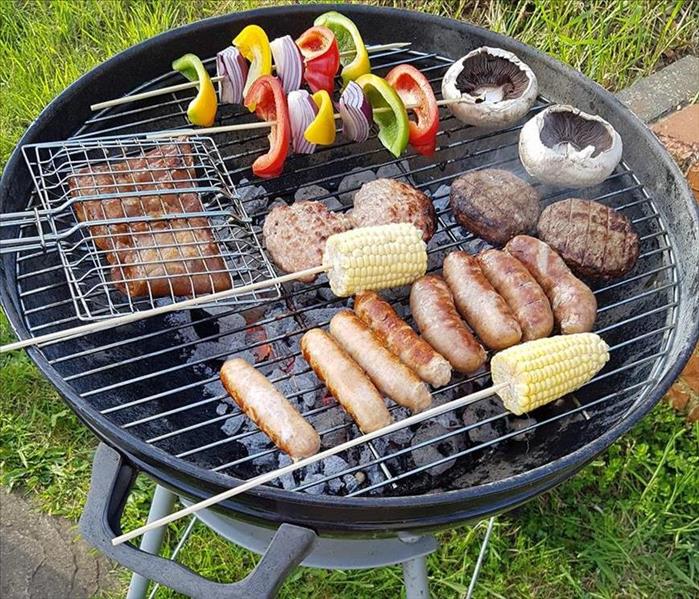 Beware of fire hazards when barbecuing this summer.
Beware of fire hazards when barbecuing this summer.
If you plan to enjoy barbecuing this summer, it’s important to be mindful of potential fire hazards which can lead to irreversible fire damage and lingering smoke damage in your Long Beach residence. Follow these simple fire safety guidelines to prevent a fire from occurring near your home this summer.
- Keep the grill outside, and avoid using your grill in garages, covered decks, screened in patios, or any area where there is a roof located above. They should also be kept at a safe distance from the house to prevent flare ups from reaching the exterior of your home.
- Keep your eye on the barbecue. If you abandon your grill, it can be knocked over or flare up, causing the surrounding area to catch fire. Make sure the grill is always supervised whenever it’s in use to avoid unnecessary fire damage.
- Regularly clean it. If you are pulling your grill out of storage, it’s important to clean off any sticky grease or hardened fat since they can cause an unexpected flare up. These pieces can easily be scraped off using a proper grill cleaner.
- Inspect it closely. If you are using a propane or gas grill, it’s important to inspect it before using it. Look for any signs of holes and potential problems in the hose. This could signal that there’s a leak. A gas leak next to a flame can cause serious problems and start a fire.
Make sure to follow these guidelines every time you fire up your grill to ensure the safety of your home and loved ones. If you experience fire damage, smoke damage, or require board up and tarping services this summer, SERVPRO of Northeast Long Beach / Lakewood is available to take your call anytime, day or night at 562-420-0030.
FIRE EXTINGUISHERS - NEED TO KNOW FACTS
4/8/2019 (Permalink)
Whether you are a home owner or renter, knowing the basic tenants of fire safety can mean the difference between minor damage or total loss. Having a fire extinguisher on the premises and knowing how to access it can keep you and your loved ones safe. Here we will review the different types of fire extinguishers and how to use one in the event of an emergency.
Fire Extinguisher Classifications
Household fire extinguishers are labeled with a specific class to fight a specific type of fire. Since using the wrong extinguisher could make the situation worse, consider one that is rated for multiple classes.
Class A: For trash, wood, and/or paper fires.
Class B: For liquids and/or grease fires.
Class C: For electrical fires.
Class D: For flammable metals (usually only needed in labs or industrial plants).
Class K: Specifically for kitchen fires when grease and oil are involved.
Fire Extinguisher Effectiveness and Size
When choosing an extinguisher, determine its effectiveness by considering the numbers on the label. Every number before the A means it is as effective as 1.25 gallons of water. For example, 2A means the fire extinguisher is as effective as 2.5 gallons of water. The numbers before B and C are a measure of the amount of square feet the fire extinguisher can put out. For example, a 20: BC fire extinguisher can extinguish a fire over 20 square feet.
Keep in mind that the extinguisher size also varies based on the weight. Typically, there are 4, 5, 10, and 20-pound extinguishers. Bigger isn’t always better; it depends how much you can physically hold and the size of your residence.
How to Use a Fire Extinguisher
A good way to remember what to do in a moment of panic is the acronym P.A.S.S.
Step 1: Pull the pin.
Step 2: Aim the extinguisher at the fire low with the nozzle at the base of the fire.
Step 3: Squeeze the handle to begin extinguishing the fire.
Step 4: Sweep the extinguisher side to side at the fire’s base until it’s out.
With these helpful tips, we hope that you remain prepared in the event of a fire. Don’t hesitate to call 9-11 if the fire spreads or if you are in need of assistance. We are here to help during the aftermath to repair damage caused by smoke, soot, and fire; call us 24/7 for all your restoration needs.
STORING PROPANE TANKS SAFELY
3/4/2019 (Permalink)
As a clean and natural energy source, propane is an easy to use and affordable product to warm homes, provide heating, and allow barbeque and cooking. It comes in both gas and liquid forms and is also highly flammable. When misused, propane poses a strong fire hazard. Following these 3 tips to store propane tanks properly will keep your home safe and reduce the chance of fire damage.
First, always store propane tanks upright and outdoors on a hard surface. Should it catch on fire, the potential for loss is much less severe. The hard surface can help prevent the container from accidentally tipping over and causing unneeded damage or harm to the tank itself. Additionally, never leave a cylinder tank inside a car or vehicle.
If you smell gas or an odor like rotten eggs, shut off the propane tank and leave immediately if there are no visible sparks or flames. Avoid using a cell phone, lights, or appliances. Notify the fire department of a potential gas leak and do not return to the building until it has been declared safe for re-entry.
Always turn off the gas line or valve to an unused tank. Leaving it open could cause a leak, leading to dangerous situations where fire or explosion may occur. Remember to treat an empty tank as if it were full, just in case there was an error.
We hope these tips keep you safe when handling propane tanks. In the case of property damage, call SERVPRO of Northeast Long Beach / Lakewood 24/7 for restoration services.
SPACE HEATER DANGERS
2/18/2019 (Permalink)
During the cold months, space heaters are a great way to warm a room in the absence of central heating. Portable heaters, however, can pose certain threats to your home. If left unattended, a space heater can easily cause a house fire or electrical overload. Remain safe and warm by remembering the following safety tips.
- Leave three feet of space around your heater to avoid igniting flammable material. Keep pets and children from disturbing the heater to avoid burns and injuries. Make sure to also remove any objects blocking air flow or covering cables or components.
- Avoid leaving a heater running throughout the day, especially unmonitored. It may overload a circuit, causing power failure or a fire. Any unusual sounds or malfunctions should be fixed right away.
- Don't use extension cords or power strips with a space heater. Plugging them directly into an outlet will help avoid a power overload.
- Avoid using a space heater in a humid environment such as a bathroom. Water in the air may cause complications with the machine, causing it to malfunction.
As you shop for a portable heater, look for a safety certification label from an independent testing organization and the following safety features to keep your home safe from fire damage.
- Shut-off features: A smart sensor will automatically shut off the machine when it overheats, and a tip-over switch does the same if the heater is knocked over.
- Ground fault circuit interrupter (GFCI) plug: This plug helps prevent electric shock. If your heater does not come equipped with one, avoid using it around moist areas.
- Sturdy cord: Many heaters come with a cord around 6 feet long. Make sure it has a sturdy design and reaches the desired areas. Remember, extension cords or power strips can cause electrical issues.
Educating yourself about the safety hazards that come with the improper use of portable heaters will help you achieve better peace of mind as you keep your home warm and comfortable during this winter season.
CAN YOU GUESS THE MOST COMMON CAUSES OF HOUSE FIRES?
9/12/2018 (Permalink)
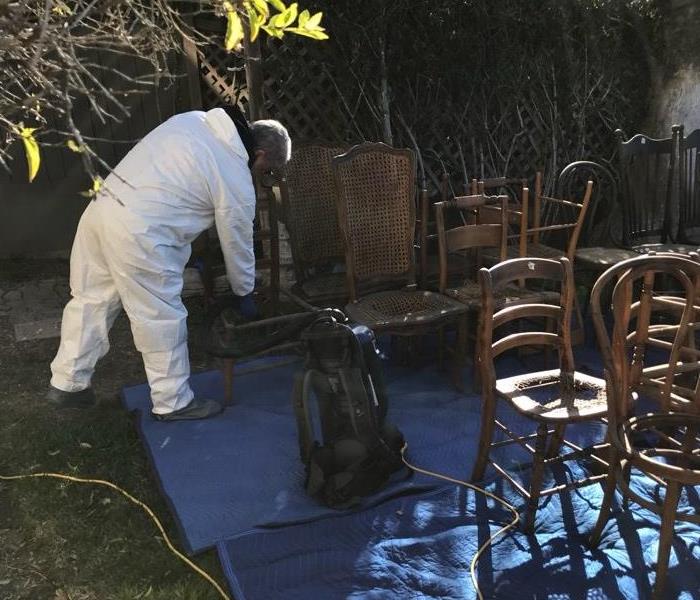 Fire damage to a home's contents in Santa Barbara
Fire damage to a home's contents in Santa Barbara
There are many situations that may cause a fire, but can you guess the most common causes of house fires? It may happen in ways you least expect. Take precautionary measures now to protect your home from the following fire instigators. If an accident occurs, SERVPRO of NE Long Beach / Lakewood has you covered.
According to the National Fire Protection Association, cooking equipment is the number one cause for house fires. Pots and pans can quickly overheat when left unattended or mishandled. Be sure to turn handles towards the middle of the stove to avoid children from accidentally grabbing it from the burner. When leaving the house, remember to turn off stove-top burners and ovens.
Moreover, smoking in bedrooms should be avoided at all costs. A cigarette butt can stay lit for hours and cause a flame after coming into contact with clothes or furniture. Open flames such as candles also pose a danger for many residents. While they may have an attractive look and smell, candles should always be blown out before you leave a room.
Furthermore, older lampshades and light fittings may build up heat, and weak bases could pose a tipping hazard. Electrical equipment such as these should be checked for faulty cords, and the power point must not be overloaded with double adapter plugs. Also be mindful of flammable liquids such as petrol, kerosene, or methylated spirits around the house. These should be kept away from heat sources and stored properly according to their label.
If you experience a fire, here are some tips to keep in mind:
- Examine you and your family for injuries and seek medical help
- If you can’t find a place to stay, your local Red Cross can help provide food and provisions
- Notify your insurance company about the fire
- Do not re-enter your home until instructed to do so. Talk to firefighters about what can be salvaged instead
- Once you are cleared to enter the building, check for important documents and keepsakes
- Make a list of your possessions and note damaged goods
- Keep track of receipts for expenses as a result of the fire
Nobody wants to come home to a irreparable damage. By knowing these common causes of house fires, you and your neighborhood can live a little bit safer. When accidents happen, SERVPRO of NE Long Beach / Lakewood is here to clean fire damage and restore your home quickly and professionally.
KID FIRE SAFETY-BE PREPARED!
8/3/2018 (Permalink)
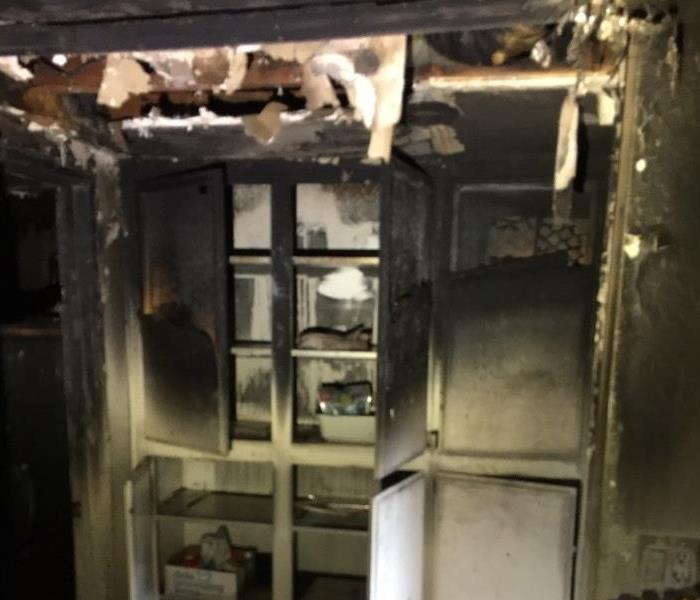 Fire damage to a Signal Hill home
Fire damage to a Signal Hill home
You may know what to do during a fire, but do your children? SERVPRO of NE Long Beach/Lakewood has faced countless losses in homes and businesses due to fire damage so we want families to be prepared. With school coming back in session soon, it's important to make sure that your kids are educated on fire safety. You never want to leave your kids home alone without the proper fire safety education and since you can't predict a fire emergency, fire safety education is key. Here are some important items to remember:
Make sure that you educate your children on what a smoke alarm looks and sounds like. Make sure they can recognize when a fire alarm has gone off and what to do when an alarm has sound. Know two or more routes to exit your home/school during a fire as well as a meeting point away from the location a safe distance from the fire. The American Red Cross suggests "Practice your fire escape plan at least twice a year and at different times of the day. Practice waking up to smoke alarms, low crawling, and meeting outside." It is crucial your children also know how to dial 9-1-1.
When making sure your home is up to fire safety standards, make sure to have escape ladders on the upper levels so that you can escape from windows to safety. The American Red Cross also suggests "use quick-release devices on barred windows and doors. Security bars without release devices can trap you in a deadly fire. If you have security bars on your windows, be sure one window in each sleeping room has a release device." It is important to make your children aware of which windows have quick releases on them and how to use them properly. Also have fire extinguishers readily available, and up-to-date and, at minimum, in the kitchen, garage and on the upper levels.
It's never too soon to start teaching your kids how to be prepared during an emergency, including fires, as they often occur in the home. SERVPRO of NE Long Beach/Lakewood is open 24/7 in case an emergency strikes. We are dedicated to helping restore your residence to pre-disaster conditions, making it “Like it never even happened”.
FIRE SEASON IS CAUSING WIDE SPREAD DAMAGE
7/13/2018 (Permalink)
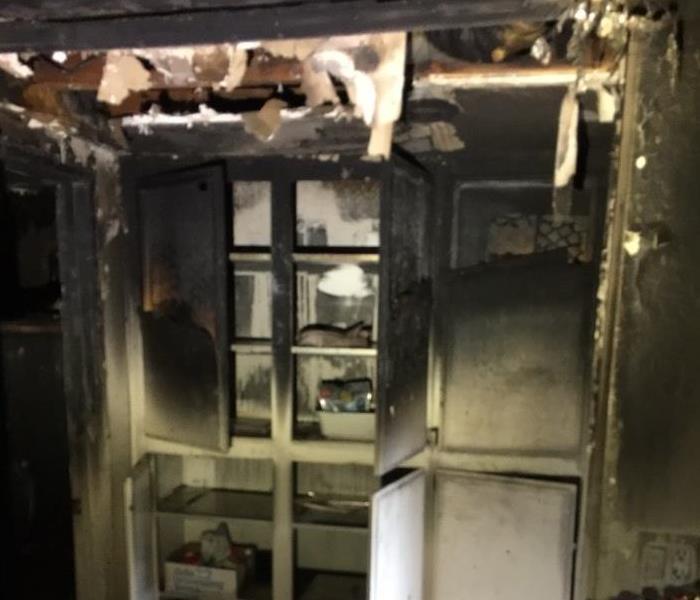 Fire damage to a home in Long Beach
Fire damage to a home in Long Beach
There have been recent Fires throughout the State, causing fire damage and smoke damage to residential and commercial properties. Here at SERVPRO of NE Long Beach/Lakewood, we’ve already responded to a number of fire losses in the last month. The overall incidents across the region cause worry among officials and scientists that fire season may come earlier to California this year, amid drought conditions, raising worries of a destructive season ahead. Last year was the deadliest and costliest fire season in the state’s history. No one wants to see another year of deadly fires.
On a personal level, it’s important to be prepared. Stay tuned in to your favorite tv or radio station to keep informed about current fire locations and their status. An informative website is www.fire.ca.gov for up-to-the-minute reports. They not only tell you if there is a fire close to you, but also the level of containment of the fire and how many acres have been impacted. Be sure to have an emergency bag packed and kept up to date in case an evacuation is announced or your property is affected.
Should your property suffer from fire or smoke damage, SERVPRO of NE Long Beach/Lakewood is available, 24/7 to help. We’ll work closely with your insurance company, providing the needed documentation and photos to assist in getting the needed approvals to move forward in cleanup, restoration and, reconstruction of your home or business. We can pack up your belongings and keep them safely stored in our warehouse until they can be returned to your property. We have worked with numerous customers affected by loss caused from fire damage, assisting them through this overwhelming process. Look to the certified, trained professionals at SERVPRO of NE Long Beach/Lakewood to help you through this difficult time. We’ll make it “Like it never even happened”.
EMERGENCY EVACUATION KIT: BE PREPARED FOR FIRE SEASON
7/6/2018 (Permalink)
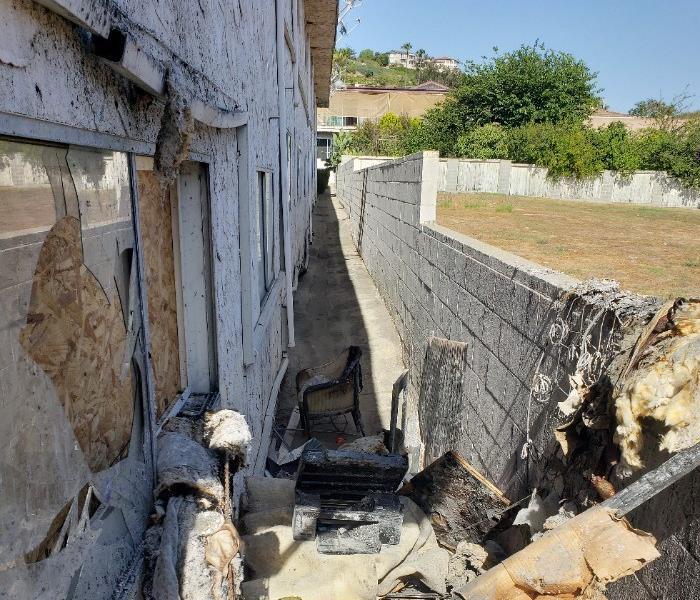 Fire damage to a building in Anaheim.
Fire damage to a building in Anaheim.
What if I Need to Evacuate My home?
Fire season is in full effect and multiple fires have started across the state of California causing fire damage to residences and businesses. Here at SERVPRO of NE Long Beach/Lakewood we work on fire restorations and repair when a disaster strikes. We also know it's extremely important to get together an Emergency Evacuation Kit. We've compiled some helpful tips for putting together an evacuation kit. It is important to update your emergency kits every year to adjust to new needs and replace anything that has expired. Ready.gov suggests you have kits ready in your home, car, and at work because you never know when a fire will cause an evacuation.
What to Pack inside the Kit:
- Scan and save all important documents on a flash drive
These include:
- Driver’s license
- The deed to your house
- Your will and/or trust
- Proof of insurance
- Medical records
- Passport
- Social security cards
- Birth certificates
- Pet paperwork
- Daily Essentials
- Flashlights
- Batteries
- Clothes
- Pet supplies
- Diapers (if needed)
- Nonperishable foods
- Hand crank/battery powered radio
- Medications (as applicable)
- First Aid Kit
- Fire Extinguisher
- Sleeping Bag/Blankets
To look up more on how to pack the perfect evacuation kit check out Ready.gov for additional tips. If your home or business experiences fire damage, call SERVPRO of NE Long Beach/Lakewood. We’re here 24/7 to help make it “Like it never even happened”.
FIRE SAFETY TIPS TO AVOID FIRE DAMAGE
7/6/2018 (Permalink)
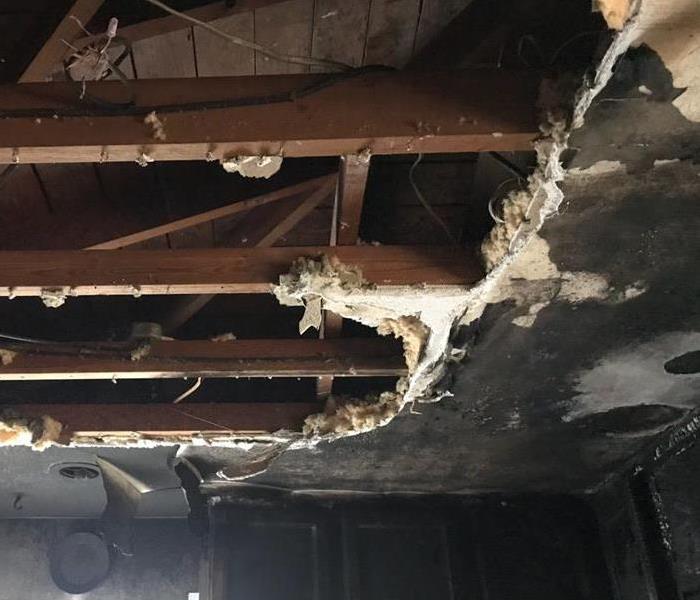 Home Fire in Tustin
Home Fire in Tustin
How to Avoid Fire Damage and Keep Your Home Safe
Fires can happen anytime/anywhere and the impact of fire damage is overwhelming. That’s why SERVPRO of NE Long Beach/Lakewood is open 24 hours a day, every day, just in case an emergency, such as a fire, strikes your home. We are always looking out for the safety of our customers and ways to assist in keeping emergencies, such as fire damage, at a minimum. With fire season in California upon us it is important to always be updated on fire safety measures in your home. Here are some recommended steps:
Smoke Detectors
-Install at least one smoke detector on every level of the home, near the bedrooms, and one in the garage.
-Test all the batteries monthly
-Clean your smoke detectors from dust and dirt to keep them working properly
Fire Escape Plan
-Establish a planned escape route for every room in the house
-Determine an outside meeting place for all family members
-Review your plans and practice a fire drill with household members twice a year
Electricity
-Use fire-safe electric outlets
-replace fraying cords
-Do not overuse one plug
Outdoor Tips
-Fire Resistant Plants
-BBQ grill away from the house
The safety and security of our customers is important to all of us at SERVPRO of NE Long Beach/Lakewood. By taking these preventative measures, you take steps toward avoiding fire damage and the loss and suffering it can cause. If you do find yourself affected by smoke damage, fire damage or other emergencies, we’re here to help. Call us 24/7 at 562-420-0030.
SMOKE AND SOOT CAUSE EXTENSIVE DAMAGE
7/2/2018 (Permalink)
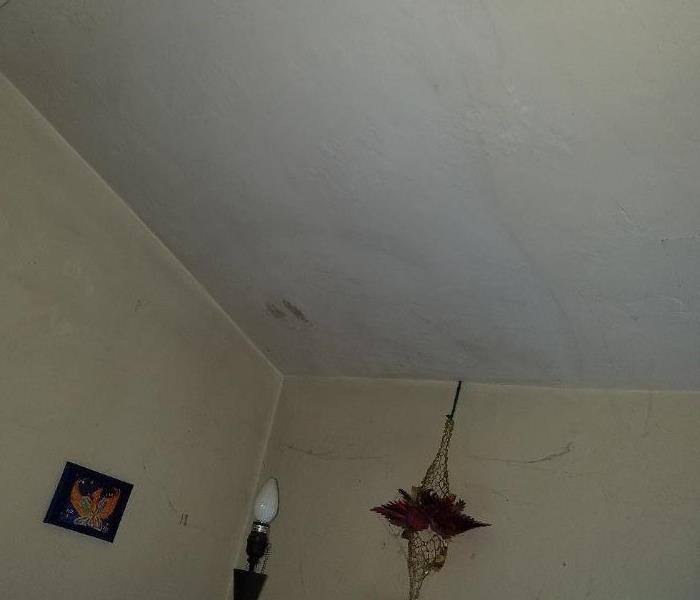 Ceiling affected by smoke damage in Long Beach residence.
Ceiling affected by smoke damage in Long Beach residence.
Smoke and soot is very invasive and can penetrate various cavities within your home, causing hidden damage and odor. SERVPRO of NE Long Beach/Lakewood has smoke damage expertise and experience, allowing us to inspect and accurately assess the extent of the damage to develop a comprehensive plan of action.
Smoke and soot facts:
- Hot smoke migrates to cooler areas and upper levels of a structure.
- Smoke flows around plumbing systems, seeping through the holes used by pipes to go from floor to floor.
- The type of smoke may greatly affect the restoration process.
Different Types of Smoke
There are two different types of smoke–wet and dry. As a result, there are different types of soot residue after a fire. Before restoration begins, SERVPRO of NE Long Beach/Lakewood will test the soot to determine which type of smoke damage occurred. The cleaning procedures will then be based on the information identified during pretesting. Here is some additional information:
Wet Smoke – Plastic and Rubber
- Low heat, smoldering, pungent odor, sticky, smeary. Smoke webs are more difficult to clean.
Dry Smoke – Paper and Wood
- Fast burning, high temperatures, heat rises therefore smoke rises.
Protein Fire Residue – Produced by evaporation of material rather than from a fire
- Virtually invisible, discolors paints and varnishes, extreme pungent odor.
Our Fire Damage Restoration Services
Since each smoke and fire damage situation is a little different, each one requires a unique solution tailored for the specific conditions. We have the equipment, expertise, and experience to restore your fire and smoke damage. We will also treat your family with empathy and respect and your property with care.
Have Questions about Fire, Smoke, or Soot Damage? Call SERVPRO of NE Long Beach/Lakewood today: 562-420-0030





 24/7 Emergency Service
24/7 Emergency Service

